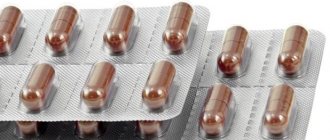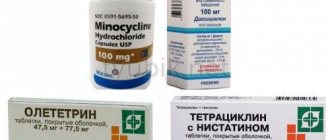Cyclomed (form - drops) belongs to the group of drugs for the treatment of eye diseases. The instructions for use highlight the following features:
How to dissolve vascular plaques, normalize blood circulation, blood pressure and forget the way to the pharmacy
- Sold only with a doctor's prescription
- During pregnancy: contraindicated
- When breastfeeding: contraindicated
- In childhood: with caution
- If kidney function is impaired: you can
- In old age: with caution
pharmachologic effect
Cyclopentolate blocks m-cholinergic receptors, thereby promoting tension in the ciliary (ciliary) muscle of the eye and simultaneous relaxation of the muscle that constricts the pupil. Relaxation of the ciliary muscle of the eye leads to the development of paralysis of accommodation - cycloplegia. Temporary paralysis of accommodation helps restore lost eye functions in some eye diseases, and also makes it possible to distinguish a spasm of accommodation from true myopia during diagnosis.
Cyclomed easily penetrates the conjunctiva of the eye. Cyclopentolate reaches maximum pharmacological activity 20-30 minutes after a single instillation of Cyclomed. Reviews of Cyclomed say that the pupil remains dilated for 7-12 hours after instillation of the drug, and in some cases much longer. Residual effects of accommodation paresis may persist for 24 hours after instillation of the drops.
Judging by the reviews, Cyclomed has an antispasmodic effect, reduces the secretion of the gastric glands, salivary, sweat, bronchial glands and pancreas. The drug in therapeutic doses has a stimulating effect on the nervous system (manifests 30-60 minutes after instillation of the drug), promoting an increase in intraocular pressure and a decrease in the tone of the vagus nerve, which leads to the development of tachycardia and a slight increase in blood pressure.
Analogues and generics
Well-known cheap analogue drugs are Atropine (atropine sulfate), Midrimax (phenylephrine and tropicamide), Midriacil (tropicamide), Tropicamide (tropicamide hydrochloride) .
Preparations with the same active ingredient (cyclopentolate) are Cycloptik (Romania), Cyclopentolate-SOLOpharm (Russia). The average cost of one bottle of Cyclomed eye drops ranges from 380 to 500 rubles per package.
Instructions for use
According to the instructions, Cyclomed is used topically by instilling 1-2 drops of the drug into the conjunctival cavity.
For inflammatory processes, one drop of the drug is instilled into the eye three times a day. In some cases, an increased dosage of Cyclomed is allowed - 1 drop every three to four hours. When instilling the solution into the conjunctival cavity, the lower lacrimal punctum should be pressed to avoid Cyclomed getting into the nasopharynx.
To carry out the fundus examination procedure, it is enough to instill one drop of Cyclomed solution one to three times a day.
To study refraction in adolescents and children, one drop of the drug is prescribed two to three times a day.
Cyclomed: instructions for use
The drug is for local use. It is prescribed for instillation into the conjunctival sac, two (one) drops at a time.
Fundus examination
Carry out from one to three installations of 1k/every 10 minutes.
Conducting refractive studies
In childhood and adolescence, 1 or 2 r/2 or 3 r/10 minute interval.
Eye inflammation
Assigned 1k/three times/day. In severe cases of the disease, one drop is allowed every few hours.
The lower point of the lacrimal should be pressed during instillation so that the drop solution does not enter the nasopharynx area.
During pregnancy
During pregnancy, Cyclomed can be prescribed only if absolutely necessary to treat the expectant mother, since there is no reliable data on the safety of the drug for this category of patients.
For children
For children under three years of age, the medicine is prescribed with great caution.
special instructions
The therapeutic effect of the drops is weakened in patients with dark iris pigment.
Elderly patients are advised to carefully monitor intraocular pressure when using Cyclomed.
Patients with hypersensitivity to atropine do not show cross-allergy to the drug Cyclomed.
For children with persistent or semi-persistent spasms of accommodation for cycloplegia, it is preferable to use a course of instillation of atropine sulfate, an analogue of Cyclomed.
Side effects
- temporary decrease in visual acuity;
- feeling of discomfort;
- redness of the conjunctiva;
- increased intraocular pressure in primary glaucoma;
- weakness, dizziness, nausea, tachycardia;
Children sensitive to cyclopentolate may experience dizziness, general weakness, vomiting, drowsiness, dry mouth, headaches, and in rare cases, tachycardia.
Overdose
In case of an overdose (taking the drug orally), tachycardia, dry skin and mucous membranes, impaired mental reactions (fatigue, incoherent speech, disorientation in space, impaired recognition of objects located close to each other and changes in the emotional background) are observed. Taking very large doses can lead to respiratory paralysis and coma.
Impact on the ability to operate machinery and vehicles
During the period of taking the drug, there are restrictions on engaging in potentially hazardous activities that require high concentration and speed of reactions.
special instructions
The drug shows less effect on dark-pigmented irises; the residual accommodation in this case can reach from 2 to 4 diopters.
The Cyclomed analogue atropine sulfate is recommended for use in children when a persistent or semi-persistent spasm of accommodation is detected. Before using Cyclomed in elderly patients, intraocular pressure should be monitored.
In patients sensitive to atropine, there are no symptoms of cross-allergy to the drug, which makes its use in this category of patients possible.
Reviews
Maria, 28 years old
I was prescribed these drops before conducting tests on my eye (my vision had deteriorated greatly after the injury). The pharmacy asked for a prescription. Before the examination, my ophthalmologist instilled them in me three times, one drop in each eye for half an hour. After the procedure, vision was completely restored within 6 hours.
Ivan, 22 years old
I was prescribed glasses; instillation of Cyclomed was required for additional examination. After use, the feeling is not pleasant - there is pain in the eyes, vision is blurred. This lasted for 10 hours or even a little more. But the glasses were chosen perfectly, in two years my vision did not deteriorate, and even improved a little, I am very pleased.
Olga, 34 years old
Now in many ophthalmology clinics these drops are prescribed before diagnostics. A contraindication to their use is increased intraocular pressure (and glaucoma); you must inform your doctor if you have such a diagnosis. I didn’t do this, then I needed monthly rehabilitation therapy.
Overdose
Symptoms: if the recommended doses are exceeded, as well as when the drug is taken orally, dry skin and mucous membranes, tachycardia, agitation and disturbance of mental reactions (incoherent speech, fatigue, impaired recognition of nearby objects and disorientation in space, changes in the emotional state) may be observed; when using the drug in very high doses - respiratory paralysis and coma.
Treatment: intravenous administration of a specific antidote - physostigmine: adults - at a dose of 2 mg (if there is no effect, repeat the administration within 20 minutes at a dose of 1-2 mg), children - at a dose of 500 mcg (if there is no effect, repeat within 5 minutes administration, taking into account that the maximum dose should not exceed 2 mg).
Contraindications for Cyclomed eye drops
"Cyclomed" eye drops, like other drugs, have their contraindications. The medication should not be used in the following cases.
- Suspicion of glaucoma or its presence. When using the medication, complete atrophy of the optic nerve may develop.
- Impaired mobility of the muscle responsible for pupil contraction.
- Individual intolerance to individual components of the drug.
There are also pathologies and conditions in which the use of pharmacological agents is dangerous, as this can lead to some complications.
Use with caution:
- in children under 3 years of age;
- elderly people;
- prostatic hyperplasia;
- with intestinal obstruction.
In all presented cases, during the therapy period the patient should be under the supervision of a specialist.
Pregnancy and lactation
Each package of the drug contains instructions for use, according to which the drug "Cyclamed" is allowed to be used during pregnancy and breastfeeding. But the specialist must take into account that such a prescription carries certain risks for the health of the fetus and child. Therefore, prescribing the drug is permissible only if the benefit to the mother significantly outweighs the possible problems after use in the child.
Contraindications
It is clear that Cyclomed has contraindications for certain groups of diseases and personal characteristics of the body. Let's see who should be careful:
- Individual sensitivity to the components of the drug.
- Glaucoma and even the slightest suspicion of it.
- Intestinal problems.
- Children under three years old.
- BPH.
Since studies have not yet yielded results regarding pregnant and breastfeeding mothers, it is better to exercise caution in this regard. Only as a last resort, if the risk of suffering from the disease is too great, can this drug be prescribed to a pregnant woman.
Side effects
A serious drug, naturally, has far from easy consequences, which should be paid attention to at their first manifestations:
- nausea,
- weakness,
- hyperemia (conjunctiva),
- blurred vision,
- dizziness,
- tachycardia,
- headache,
- drowsiness,
- rapid pulse,
- allergic reaction (skin rash).
Don't wait until all the symptoms appear. As soon as you feel at least one of them, immediately contact an ophthalmologist.
If you also use m-choline blockers in parallel with this drug, you may risk increased side effects from Cyclomed itself. And if the drugs Phenylephrine and Mezaton enhance the effect of the drops, then Pilocarpine greatly weakens it.
Some Important Notes
Now let's look at several features of taking this drug that cannot be ignored:
- Measure intraocular pressure if you are over 60 years old.
- If you have a dark iris, the effect of the drops may not be strong enough.
- Those who have photophobia and take Cyclomed should wear sunglasses during treatment.
- Gently press the injection site with your finger to prevent the medicine from entering the nasopharynx. If this is ignored, you may suffer from increased blood pressure.
Naturally, all information about the drug Cyclomed is presented in a simplified form, as we immediately warned you. Because we want you to be able to understand all the main functions of this eye product.
If you want a medical description, please consult the official instructions or an ophthalmologist. He will not only be able to explain to you unclear terms and names, but will also tell you whether this drug is right for you.
And for now, we say goodbye and want to assure you that we were warm and pleasant with you! We will be waiting for you again, dear user, on our educational page. And if you can leave us a sincere review and share this link with your friends, we will tell you from the bottom of our hearts: “Thank you!” See you soon!
Cyclomed price
You can buy Cyclomed at any pharmacy, after checking the availability and cost on the appropriate online resource. When making a purchase, the pharmacist may require you to present a prescription. The average price range for the drug in Moscow pharmacies is presented below:
| Name of pharmacy chain | Price, rubles |
| Sun | 625 |
| Onfarm | 539 |
| Nova Vita | 705 |
| Terra Vita | 545 |
| Samson Pharma | 662 |
Cyclomed's analogs
The drug Cyclomed has a number of similar drugs in different price categories. Drug analogues include:
- Midriacil is an analogue of Cyclomed, which is used for examinations in ophthalmological practice. According to patient reviews, this drug causes fewer adverse reactions.
- Tropicamide is an anticholinergic drug that blocks the pupillary sphincter and ciliary muscle, thereby causing mydriasis.
- The drug Unitropic is an eye drop that is used before diagnostic procedures in ophthalmology.
Article on the topic: Treatment of pharyngitis with symptoms at home
Cyclomed eye drops
The drug Cyclomed, which has the ability to dilate the pupil, is actively used in ophthalmology. Changing the pupil is required to combat eye diseases (inflammation and false myopia), for examinations, as well as for recovery after surgery.
Cyclomed eye drops - pharmacological action
The action of the drops is due to the blocking of m-lolinergic receptors, which causes relaxation of the muscle intended to constrict the pupil. Paralysis of accommodation, caused by relaxation of this muscle, allows you to restore the functioning of the organs of vision affected by diseases. Also, pupil enlargement helps to determine myopia and distinguish it from a spasm of accommodation.
Cyclomed eye drops penetrate quickly and reach maximum activity after twenty minutes. Pupil dilation is then observed for seven to twelve hours.
Composition of Cyclomed
The product is dispensed in a transparent package with a dropper on it. One milliliter of the substance contains 0.01 grams of cyclopentolate hydrochloride and 0.0001 grams of auxiliary ingredients. These include:
- sodium chloride;
- water for injections;
- benzalkonium chloride;
- disodium edetate.
The shelf life of the medicine is two years.
Cyclomed eye drops have similar properties to the analogue drug Cycloptic.
Cyclomed - indications for use
The drug can be prescribed for the need to dilate the pupil when diagnosing diseases and combating inflammatory pathologies (keratitis, uveitis), as well as during operations.
Cyclomed eye drops, according to the instructions, are used topically:
- In order to study the parameters of the fundus, the patient is given a drop of drops every ten minutes.
- To conduct a refractive examination, children and adolescents need to instill two drops of the product three times a day.
- The fight against inflammatory processes involves instilling a drop three times a day. Often the dose can be increased to one drop every four hours.
Cyclomed - contraindications
Treatment with Cyclomed should not be carried out in the following cases:
- persons suffering from glaucoma or suspected of having this disease;
- for injuries and cuts to the sphincter of the pupil;
- in the presence of intolerance to the components of the product.
Only after preliminary consultation with a doctor, Cyclomed 1 eye drops can be used by the following groups of people:
- children under three years of age;
- having prostate diseases;
- those suffering from intestinal obstruction;
- pregnant women and nursing mothers.
Cyclomed - side effects and overdose
When using this drug, the following side effects may occur:
- weakness;
- dizziness;
- burning;
- redness of the eyes;
- blurred vision;
- tachycardia;
- nausea;
- increased intraocular pressure;
- feeling of dryness in the mouth.
Exceeding permissible doses may be accompanied by symptoms:
- dry skin surface;
- excited state;
- cardiopalmus;
- disorientation;
- fatigue;
- incoherence of speech.
In case of overdose, the patient is given the antidote physostigmine drops.
special instructions
Throughout the course of using the drug, it is not recommended to engage in activities that require concentration, which is especially important when driving. If your job requires you to constantly drive, it is worth making an appointment with your doctor, who may be able to find an alternative.
Also, you should not put on lenses for twenty minutes after taking the composition.









